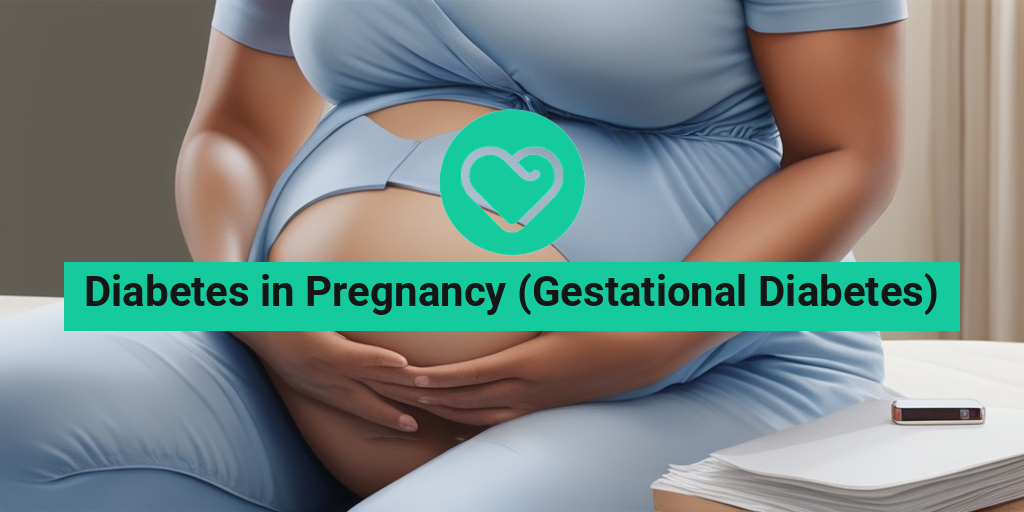What is Gestational Diabetes?
Gestational diabetes, also known as gestational diabetes mellitus (GDM), is a type of diabetes that develops during pregnancy, usually in the second or third trimester. It’s a common condition, affecting about 9.2% of pregnancies in the United States alone. But what exactly is gestational diabetes, and how does it differ from other types of diabetes?
What causes gestational diabetes?
The exact causes of gestational diabetes are still not fully understood, but several factors contribute to its development. During pregnancy, the placenta produces various hormones that help the baby grow and develop. However, these hormones can also block the action of insulin, a hormone produced by the pancreas that regulates blood sugar levels. This is known as insulin resistance.
As a result, the body produces more insulin to compensate for the insulin resistance. However, in some women, the pancreas cannot produce enough insulin to meet the increased demand, leading to high blood sugar levels and gestational diabetes.
How is gestational diabetes different from other types of diabetes?
Gestational diabetes is often confused with other types of diabetes, such as type 1 or type 2 diabetes. However, gestational diabetes is a unique condition that develops only during pregnancy. It’s not the same as having pre-existing diabetes before pregnancy.
In fact, gestational diabetes often goes away after pregnancy, but it can increase the risk of developing type 2 diabetes later in life. Women who have had gestational diabetes are also more likely to develop it again in future pregnancies.
Gestational Diabetes Symptoms
Many women with gestational diabetes don’t experience any noticeable symptoms. However, some may experience mild symptoms, such as:
- Frequent urination: As the body tries to rid itself of excess glucose, you may need to urinate more frequently.
- Increased thirst: As you urinate more, you may feel thirsty more often.
- Fatigue: High blood sugar levels can cause feelings of exhaustion and weakness.
- Blurred vision: High blood sugar levels can cause the lens in the eye to swell, leading to blurred vision.
- : Some women may experience headaches due to high blood sugar levels.
It’s essential to note that these symptoms can be mild and may not be noticeable, which is why screening for gestational diabetes is crucial during pregnancy.
If you’re concerned about gestational diabetes or have questions about your pregnancy, it’s always best to consult with your healthcare provider. They can provide personalized guidance and support throughout your pregnancy journey. Additionally, resources like Yesil Health AI (yesilhealth.com) can offer evidence-based health answers and insights to help you make informed decisions about your health. 🤰♀️
Stay tuned for the next part of this article, where we’ll dive deeper into the diagnosis, treatment, and management of gestational diabetes! 📚

Causes and Risk Factors of Gestational Diabetes
Gestational diabetes, a type of diabetes that develops during pregnancy, affects millions of women worldwide. While the exact causes of gestational diabetes are still not fully understood, research has identified several risk factors that can increase a woman’s likelihood of developing the condition.
What Causes Gestational Diabetes?
The exact cause of gestational diabetes is still unknown, but it’s believed to be related to hormonal changes during pregnancy. Hormones produced by the placenta can block the action of insulin, leading to high blood sugar levels. Additionally, the placenta produces other hormones that can increase blood sugar levels, making it harder for insulin to do its job.
Risk Factors for Gestational Diabetes
While any woman can develop gestational diabetes, some women are at a higher risk due to certain factors. These include:
- Age: Women over 35 years old are at a higher risk of developing gestational diabetes.
- Family history: Having a family history of diabetes or gestational diabetes increases a woman’s risk.
- Obesity: Being overweight or obese is a significant risk factor for gestational diabetes.
- Previous pregnancy complications: Women who have had gestational diabetes in a previous pregnancy or have delivered a baby over 9 lbs. are at a higher risk.
- Race and ethnicity: Women from certain racial and ethnic groups, such as African American, Hispanic, or Native American, are at a higher risk.
- Multiple pregnancy: Carrying multiple babies increases the risk of gestational diabetes.
- Polycystic ovary syndrome (PCOS): Women with PCOS are at a higher risk of developing gestational diabetes.
- Sleep apnea: Women with sleep apnea are at a higher risk of developing gestational diabetes.
It’s essential to note that many women who develop gestational diabetes do not have any known risk factors. Therefore, it’s crucial for all pregnant women to be screened for gestational diabetes during their pregnancy.
How is Gestational Diabetes Diagnosed?
Gestational diabetes is typically diagnosed between 24 and 28 weeks of pregnancy, but it can occur earlier in some cases. The diagnosis is usually made using a combination of screening tests and diagnostic tests.
Screening Tests
The first step in diagnosing gestational diabetes is a screening test, which is usually done between 24 and 28 weeks of pregnancy. The screening test is a simple blood test that measures the level of glucose in the blood one hour after consuming a sugary drink. This test is called the glucose challenge test.
If the results of the glucose challenge test are abnormal, a more comprehensive test called the oral glucose tolerance test (OGTT) is performed. During the OGTT, the woman is given a sugary drink and her blood sugar levels are measured one, two, and three hours after consumption.
Diagnostic Tests
If the results of the OGTT are abnormal, a diagnosis of gestational diabetes is made. In some cases, a woman may be diagnosed with gestational diabetes earlier in her pregnancy if she has risk factors or symptoms.
It’s essential to diagnose gestational diabetes early to prevent complications during pregnancy and childbirth. With proper management and care, women with gestational diabetes can have a healthy pregnancy and baby. 🤰♀️

Gestational Diabetes Treatment and Management
Receiving a diagnosis of gestational diabetes can be overwhelming, but with the right treatment and management plan, you can ensure a healthy pregnancy and birth. In this section, we’ll explore the various treatment options and management strategies for gestational diabetes.
Monitoring Blood Sugar Levels
Regular blood sugar monitoring is crucial in managing gestational diabetes. Your healthcare provider will recommend how often you should check your blood sugar levels, but typically, it’s done:
- Before meals
- After meals (1-2 hours)
- At bedtime
This will help you understand how different foods and activities affect your blood sugar levels, allowing you to make informed decisions about your diet and lifestyle.
Insulin Therapy
In some cases, insulin therapy may be necessary to manage gestational diabetes. Insulin injections can help regulate blood sugar levels, especially if diet and exercise aren’t enough. Your healthcare provider will determine the appropriate dosage and frequency of insulin injections.
Oral Medications
In rare cases, oral medications like metformin may be prescribed to help manage gestational diabetes. However, this is typically only recommended if insulin therapy isn’t effective or if you have a contraindication to insulin.
Lifestyle Changes
Making healthy lifestyle changes can significantly impact your gestational diabetes management. This includes:
- Healthy eating habits: Focus on whole, unprocessed foods like fruits, vegetables, whole grains, lean proteins, and healthy fats.
- Regular physical activity: Aim for at least 30 minutes of moderate-intensity exercise, like brisk walking, per day.
- Stress management: Engage in stress-reducing activities like meditation, yoga, or deep breathing exercises.
- Getting enough sleep: Aim for 7-8 hours of sleep per night to help regulate blood sugar levels.
By incorporating these lifestyle changes, you can better manage your gestational diabetes and reduce the risk of complications.
Gestational Diabetes Diet and Nutrition
A well-planned diet is essential in managing gestational diabetes. The goal is to maintain stable blood sugar levels and provide your body with the necessary nutrients for a healthy pregnancy. Here are some dietary tips to get you started:
Choose Complex Carbohydrates
Focus on complex carbohydrates like whole grains, fruits, and vegetables, which are rich in fiber and nutrients. These foods will help regulate blood sugar levels and provide sustained energy.
Incorporate Protein-Rich Foods
Protein-rich foods like lean meats, fish, eggs, dairy, and legumes can help regulate blood sugar levels and provide essential amino acids for fetal growth.
Healthy Fats Are Essential
Healthy fats like avocados, nuts, and olive oil are crucial for fetal development and can help regulate blood sugar levels.
Limit Added Sugars and Refined Carbohydrates
Limit or avoid added sugars and refined carbohydrates like white bread, sugary drinks, and sweets, which can cause blood sugar spikes and worsen gestational diabetes.
Stay Hydrated
Drink plenty of water throughout the day to help regulate blood sugar levels and prevent dehydration.
Remember, everyone’s nutritional needs are different, and it’s essential to work with a registered dietitian or healthcare provider to develop a personalized meal plan that meets your unique needs. 🥗
By following these dietary tips and incorporating healthy lifestyle changes, you can effectively manage your gestational diabetes and ensure a healthy pregnancy and birth. 💕

Exercise and Physical Activity for Gestational Diabetes
When it comes to managing gestational diabetes, exercise and physical activity play a crucial role in maintaining blood sugar levels and overall health. Regular physical activity can help regulate insulin sensitivity, reduce the risk of complications, and even improve the overall pregnancy experience. 🏋️♀️
The Benefits of Exercise for Gestational Diabetes
Exercise has numerous benefits for women with gestational diabetes, including:
- Improved insulin sensitivity: Regular physical activity helps the body respond better to insulin, reducing the risk of high blood sugar levels.
- Weight management: Exercise can help with weight loss and maintenance, which is essential for managing gestational diabetes.
- Reduced risk of complications: Regular physical activity can lower the risk of gestational diabetes-related complications, such as preeclampsia and cesarean delivery.
- Enhanced mood and energy: Exercise releases endorphins, which can help alleviate stress, anxiety, and fatigue associated with pregnancy and gestational diabetes.
Safe Exercises for Gestational Diabetes
It’s essential to choose exercises that are safe and suitable for pregnant women with gestational diabetes. Some excellent options include:
- Brisk walking: A low-impact exercise that can be done almost anywhere, brisk walking is an excellent way to get started with physical activity.
- Swimming: Swimming is a low-impact exercise that can help improve cardiovascular health without putting excessive strain on the joints.
- Cycling: Stationary cycling or using a recumbent bike is a great way to improve cardiovascular fitness while minimizing the risk of injury.
- Prenatal yoga: Modified yoga exercises can help improve flexibility, balance, and strength while reducing stress and anxiety.
Exercise Precautions and Considerations
Before starting any exercise program, it’s essential to consult with a healthcare provider to discuss any precautions or considerations. Some important factors to keep in mind include:
- Listen to your body: If you experience any discomfort, pain, or vaginal bleeding, stop exercising immediately and consult your healthcare provider.
- Avoid high-impact exercises: High-impact exercises, such as running or jumping, can increase the risk of injury or complications.
- Stay hydrated: Drink plenty of water before, during, and after exercise to prevent dehydration.
- Monitor blood sugar levels: Regularly check blood sugar levels before and after exercise to ensure they remain within a healthy range.
—
Gestational Diabetes Complications and Prevention
Gestational diabetes can increase the risk of various complications during pregnancy, childbirth, and even after delivery. Understanding these potential complications and taking steps to prevent them can help ensure a healthy pregnancy and birth. 🤰♀️
Potential Complications of Gestational Diabetes
Some potential complications associated with gestational diabetes include:
- Preeclampsia: High blood pressure and protein in the urine can increase the risk of preeclampsia, a condition that can be life-threatening for both mother and baby.
- Fetal macrosomia: Excessive fetal growth can increase the risk of complications during delivery and birth injuries.
- Cesarean delivery: Gestational diabetes can increase the risk of cesarean delivery, which can lead to longer recovery times and increased risk of complications.
- Preterm labor: Gestational diabetes can increase the risk of preterm labor, which can lead to respiratory and other health problems for the baby.
Preventing Complications of Gestational Diabetes
To reduce the risk of complications, it’s essential to:
- Monitor blood sugar levels: Regularly check blood sugar levels to ensure they remain within a healthy range.
- Follow a healthy diet: Eat a balanced diet that is low in sugar and refined carbohydrates, and high in fiber and nutrients.
- Stay physically active: Engage in regular physical activity, such as brisk walking or swimming, to improve insulin sensitivity and overall health.
- Attend regular prenatal appointments: Regular check-ups with a healthcare provider can help identify any potential complications early on.
By understanding the potential complications of gestational diabetes and taking steps to prevent them, women can reduce the risk of adverse outcomes and ensure a healthy pregnancy and birth. 💕

Frequently Asked Questions about Diabetes in Pregnancy (Gestational Diabetes)
What is Diabetes in Pregnancy (Gestational Diabetes)?
Diabetes in pregnancy, also known as gestational diabetes, is a type of diabetes that develops during pregnancy, usually in the second or third trimester. It is caused by hormonal changes and insulin resistance, which can lead to high blood sugar levels.
What Causes Gestational Diabetes in Pregnancy?
The exact cause of gestational diabetes is not fully understood, but it is thought to be related to hormonal changes and insulin resistance during pregnancy. Factors that may increase the risk of developing gestational diabetes include:
- Family history of diabetes
- Obesity
- Previous history of gestational diabetes
- Multiple pregnancy (twins, triplets, etc.)
- Polycystic ovary syndrome (PCOS)
Can Eating Too Much Sugar During Pregnancy Cause Gestational Diabetes?
No, eating too much sugar during pregnancy does not directly cause gestational diabetes. However, consuming high amounts of sugar can contribute to insulin resistance, which can increase the risk of developing gestational diabetes.
Can Gestational Diabetes Improve During Pregnancy?
In some cases, gestational diabetes can improve during pregnancy with proper management, including diet, exercise, and insulin therapy if necessary. However, it is essential to work closely with a healthcare provider to monitor blood sugar levels and adjust treatment as needed.
Difference Between Diabetes in Pregnancy and Gestational Diabetes?
Diabetes in pregnancy refers to any type of diabetes that occurs during pregnancy, including pre-existing diabetes (type 1 or type 2) and gestational diabetes. Gestational diabetes, on the other hand, is a specific type of diabetes that develops during pregnancy and usually goes away after delivery.
How Does Gestational Diabetes Affect Pregnancy?
Gestational diabetes can increase the risk of complications during pregnancy, such as:
- Fetal macrosomia (large baby)
- Preeclampsia
- Preterm labor
- Cesarean delivery
However, with proper management and care, many women with gestational diabetes can have a healthy pregnancy and baby.
Overt Diabetes in Pregnancy vs Gestational Diabetes?
Overt diabetes in pregnancy refers to pre-existing diabetes (type 1 or type 2) that is present before pregnancy. Gestational diabetes, on the other hand, develops during pregnancy and usually goes away after delivery.
Diabetes Mellitus in Pregnancy vs Gestational Diabetes?
Diabetes mellitus in pregnancy refers to any type of diabetes that occurs during pregnancy, including pre-existing diabetes (type 1 or type 2) and gestational diabetes. Gestational diabetes is a specific type of diabetes that develops during pregnancy and usually goes away after delivery.
I hope this FAQ section helps answer some of the most common questions about diabetes in pregnancy (gestational diabetes)! 🤰♀️💡




